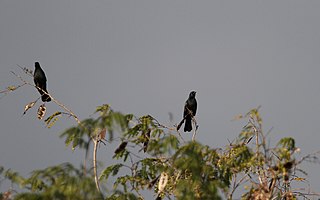
The sharp-shinned hawk or northern sharp-shinned hawk, commonly known as a sharpie, is a small hawk, with males being the smallest hawks in the United States and Canada, but with the species averaging larger than some Neotropical species, such as the tiny hawk. The taxonomy is far from resolved, with some authorities considering the southern taxa to represent three separate species: white-breasted hawk, plain-breasted hawk, and rufous-thighed hawk. The American Ornithological Society and some other checklists keep all four species conspecific.

The mangrove black hawk is a neotropical bird of prey in the family Accipitridae native to South and Central America. Briefly treated as a distinct species, Buteogallus subtilis, recent evidence strongly suggests it should be considered a subspecies of the common black hawk.

The black-chested buzzard-eagle is a bird of prey of the hawk and eagle family (Accipitridae). It lives in open regions of South America. This species is also known as the black buzzard-eagle, the gray buzzard-eagle, or analogously with "eagle" or "eagle-buzzard" replacing "buzzard-eagle", or as the Chilean blue eagle. It is sometimes placed in the genus Buteo.

The Gundlach's hawk is a species of bird of prey in the family Accipitridae. It was formerly placed in the genus Accipiter. It is one of 21 endemic bird species of Cuba. The common name and Latin binomial commemorate the German-Cuban ornithologist Juan Cristobal Gundlach (1810–1896). It is threatened by habitat loss and human persecution.

The black-collared hawk is a species of bird of prey in the family Accipitridae. It is monotypic within the genus Busarellus. It has a widespread range of presence, from western Mexico to Uruguay. Its natural habitats are subtropical or tropical moist lowland forests, subtropical or tropical swamps, and swamps.

The rufous crab hawk or rufous crab-hawk, is a Near Threatened species of bird of prey in subfamily Accipitrinae, the "true" hawks, of family Accipitridae. It is found on Trinidad and along the South American coastline from eastern Venezuela to southern Brazil.

The white-necked hawk is a Vulnerable species of bird of prey in the subfamily Accipitrinae, the "true" hawks, of family Accipitridae. It is endemic to Brazil.

The mantled hawk is a South American species of bird of prey in the family Accipitridae.

The slate-colored hawk is a species of bird of prey in the family Accipitridae: the hawks, eagles, and allies. It is found in the Amazon rainforest in Brazil, Bolivia, Peru, Ecuador, Colombia, Venezuela, and French Guiana.

The red-shouldered blackbird, known in Cuban Spanish as mayito de la ciénaga or sargento cubano and turpial de hombros rojos, is a species of passerine bird in the family Icteridae endemic to Cuba. It is similar to other species in the genus Agelaius, but recent research has established it as a separate species from the closely-related red-winged blackbird.

The brown-headed crow is a passerine bird of the genus Corvus in the family Corvidae. Endemic to Indonesia, it has a fragmented distribution in subtropical or tropical moist lowland forest and subtropical or tropical mangrove forest. It is threatened by habitat destruction and the IUCN has rated it as being "near-threatened".

The Cuban blackbird is a species of bird in the family Icteridae.

The West Indian woodpecker is a species of bird in subfamily Picinae of the woodpecker family Picidae. It is found in the Bahamas, the Cayman Islands and Cuba.

The Cuban green woodpecker is a species of woodpecker in the family Picidae and tribe Melanerpini, known locally in Cuban Spanish as carpintero verde. It is the only species within the genus Xiphidiopicus and is one of two woodpeckers endemic to Cuba. It is the most widespread and common woodpecker in Cuba, inhabiting primarily woodlands, as well as dry and wet forests, pine forests and mangroves. The population of the Cuban green woodpecker is stable and its status is listed as "Least Concern".

The Cuban oriole is a species of songbird in the family Icteridae. It is endemic to Cuba.

The Bahama oriole is a species of songbird in the New World blackbird family Icteridae. It is endemic to the Bahamas, and listed as endangered by the IUCN Red List.

The common black hawk is a bird of prey in the family Accipitridae, which also includes the eagles, hawks, and vultures.





















